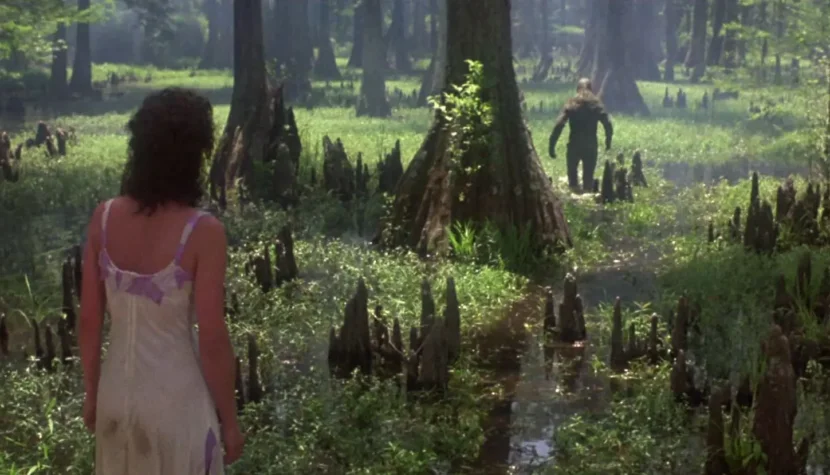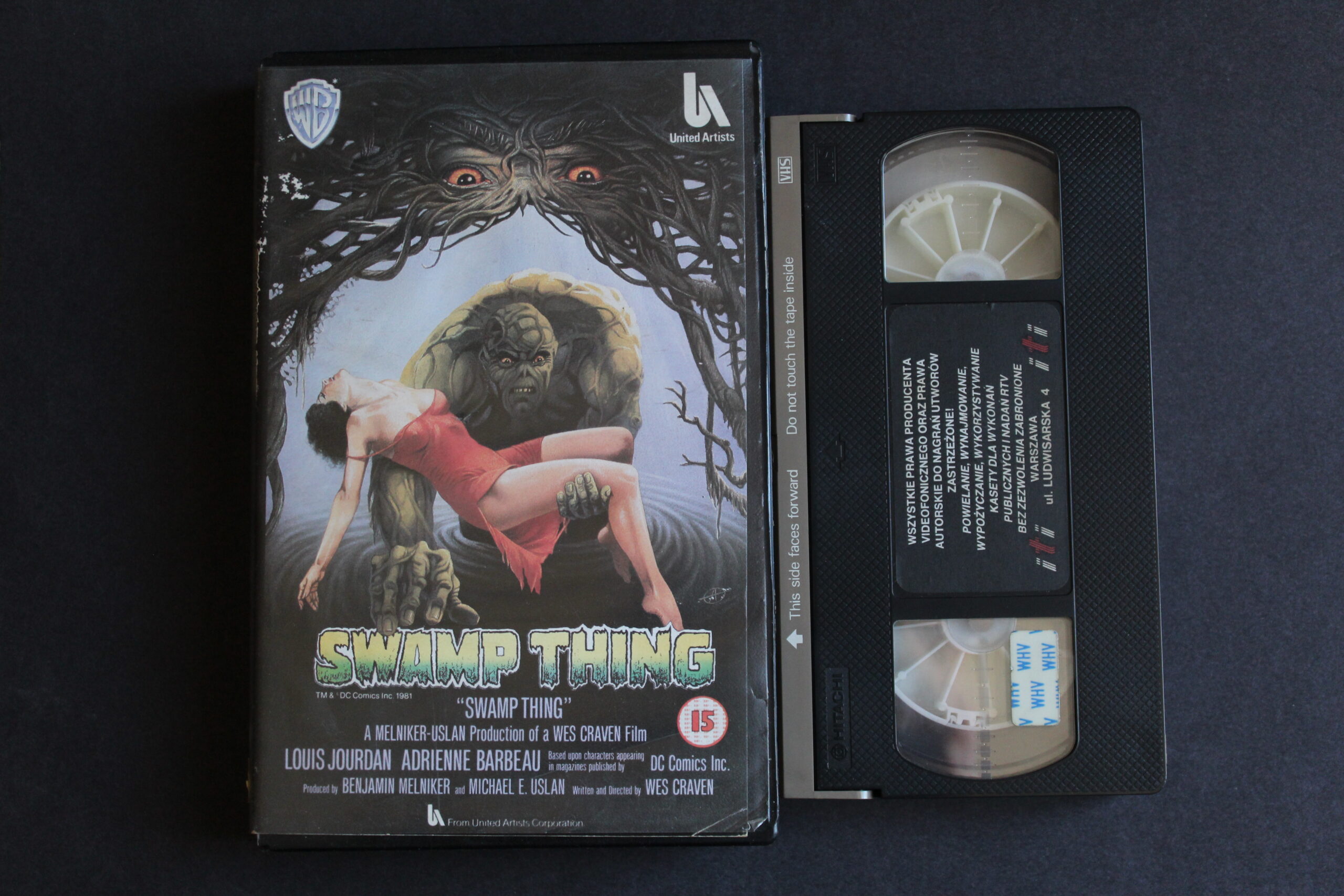SWAMP THING. Wes Craven in the World of DC Comics

“Second-tier pop culture? The only hero no one would want to become? A knockoff of the Toxic Avenger?” The story of the Swamp Thing is incredibly colorful, and its cinematic adaptation carries the label of a B-movie, though it was directed by none other than the maestro himself, Wes Craven.
For those less familiar with the intricacies of the DC Comics universe(s) — Swamp Thing is not some quirky character from humorous episodes. His fate has often intertwined with the Justice League and John Constantine, with whom he co-founded “Justice League Dark”, and new comics featuring this character are still being published to this day (an updated version of the 1980s series was released in Poland on April 18).

Swamp Thing debuted in 1971 in “The House of Secrets”. A year later, he got his own title, and in the very first issue — as is usually the case — his nemesis, Doctor Arcane, was introduced. The mad scientist also appeared in the film, portrayed by Louis Jourdan, just before taking on his most famous role as the villain in “Octopussy”, a James Bond film. The first series of comics lasted only five years, as there clearly wasn’t a solid vision for it (in the last battle, Swamp Thing fought in human form — who would want to watch that?!), and everything indicated that Alec Holland and his alter ego would share the same fate as Ultra-Man, the Puzzler, Quakemaster, and other failed DC experiments.
Wes Craven (already recognized for “The Last House on the Left” and “The Hills Have Eyes”) brought Swamp Thing back into the spotlight. The moderate success of the film adaptation encouraged the publisher to revive this fascinating embodiment of nature’s forces. What’s more, Swamp Thing was then written by Alan Moore, the renowned creator of “V for Vendetta”, “Watchmen”, and “The Killing Joke” — one of the most popular stories featuring Batman and the Joker. It was under Moore’s pen that the Swamp Thing’s tale gained a darker tone, incorporating philosophical themes about human nature and our relationship with the planet we so readily destroy.
You won’t find this depth in the movie, which has a much lighter tone. But despite its modest budget of just two and a half million dollars, it didn’t receive the overwhelmingly negative reception one might expect from its apparent cheapness. Roger Ebert, one of America’s most respected critics, wrote of the film, “There is beauty in this film if you know where to look,” and awarded it three out of four stars. So, where should you look?

Every movie — regardless of budget, genre, or release date — touches on one of two themes (and, in the best cases, both): love and death. The presence of at least one (whether as an event, threat, or expectation) is the foundation of all non-abstract scripts, but in low-budget, genre films, the viewer is often confronted with shallow emotions serving purely as entertainment. Love is romantic or physical, and death doesn’t depress; more often, it amuses with guts and gallons of blood spraying everywhere after an encounter with a lawnmower (yes, this is a nod to “Braindead”). Craven was fully aware of this, using his extraordinary talent to engage the audience in seemingly trivial stories.
Unlike the brutal films of the 1970s, which I mentioned earlier, “Swamp Thing” more frequently evokes Eros than Thanatos. The love between siblings, love for nature, and finally, the love between two people who exchange tender words, even when one of them becomes a monster. The result is reminiscent of the first season of “Twin Peaks“, where the soap-opera-like conventions and melodramatic love stories were interwoven with a mysterious atmosphere, set in broad daylight rather than the dark of night. This comparison is even supported by the casting, as Alec Holland, before his transformation, shares the same face as Leland Palmer. And in Ray Wise’s rich filmography (lately dominated by B-movies), this role still shines particularly brightly. As a scientist-playboy, the demonic host of Bob works almost as well as Robert Downey Jr. does in the skin of Tony Stark.
For today’s viewers, the love story between Holland and Alice Cable (played by Adrienne Barbeau, a horror legend from the 1980s) might seem improper and crude. Alongside tender moments, there are also aggressive ones that would, at best, result in social ostracism today. Wise occasionally channels Sean Connery’s Bond from “Goldfinger”, who practically committed assault, or Harrison Ford, who in almost all of his films won the hearts of his love interests through force. From the start, his character imposes himself on the newly arrived Alice, and when he achieves scientific success (making dead floorboards bloom), he aggressively grabs her and forces a kiss. Such behavior was always approved of in films from that era, but it’s hard to imagine the real-world reactions being the same.

Women don’t have it easy in “Swamp Thing”. Upon her arrival, Alice is met with the dismissive comment, “They sent a woman?” and when Holland invites her on an impromptu trip, she has to endure remarks from his companions like “stupid woman.” She also gets the usual “mansplaining” about DNA structure, while Arcane’s partner is told, “Darling, bring me a glass of cognac.” Some may say, “Those were the times,” and perhaps it’s a good thing we have a rich documentation of inappropriate behaviors to serve as a warning. Craven tries to fight this as well, falling into a stereotype of the era but still allowing Alice to stand up for herself and come out on top. She is the prototype of Sidney Prescott, who, fourteen years later, became the first scream queen to prove that such a character could be feisty and intelligent.
“Swamp Thing” is somewhat of a low-budget precursor to “The Shape of Water” — a story about love that transcends species and the fight against those who seek to stand in its way. As a film from 1982, it has my endless affection, but if I were to revisit “Swamp Thing” today, I’d prefer to see a moody horror film in the style of “A Quiet Place” or “It Comes at Night”, with a script by Alan Moore, of course.

